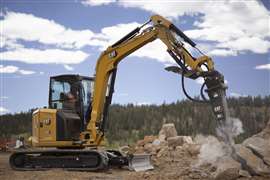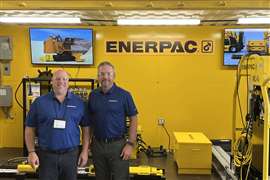Vertical endeavors
16 March 2015

Montreal-based Fraco has seen a breakthrough with construction hoists in North America, according to Jacques Lainé, director of marketing for the company.
“In February 2012, Fraco delivered its first SEH Series construction elevators to the new Research Centre of University of Montreal Health Center (RC-UMHC),” Lainé says. “Thirty months later, we can say that we have been busy and continue to gradually promote new products across all America.”
Breakthrough of the SEH Series construction hoists in the U.S. market began in early 2014, Lainé says, when construction on a major condo development began. Shortly after, in March, Fraco completed a double cab model which is made of galvanized and stainless steel and was delivered to a large rental company on the West Coast.
With a length of 15 feet, 6 inches, the unit is equipped with a counterweight that allows movement speeds over 300 feet per minute. The unit has also been designed to move along Alimak masts.
“This cooperation could possibly result in a greater presence of Fraco in the U.S.,” Lainé says.
Meanwhile, in its home country, Fraco saw the delivery of SEH Series units from dealers in the Prairies and Maritimes. The single-cabin units had a lifting capacity of 6,000 pounds and a speed of 130 feet per minute. The units have been installed on a 24-story residential condo tower and on another 12-story building.
However, Lainé says, “the highlight of the last two years remains the delivery of seven units to the Construction Santé-Montréal consortium which is responsible for the construction of the UMHC.”
As part of this mega institutional project, all units of the SEH Series were installed inside the main building. The project started in July 2013, and the deliveries of the units were completed in November 2013.
Two units include standard features (capacity and dimensions) of a SEH 6000; four others offer a broader floor, and the last one is distinguish itself by its large size.
“In light of these achievements, it is clear that Fraco has positioned itself quickly as one of the suppliers of construction hoists in North America,” Lainé says. “Many other projects are awaiting confirmation and interest for the SEH Series models is undeniable. In addition, we have entered some industrial markets with the SEL Series industrial lifts. Our backlog also includes a transport platform operating with a rack and pinion system; a technology that Fraco has integrated with all types of elevators from its alliance with a Swedish partner.”
Northern platforms
Also in Canada, Hydro Mobile continues to increase productivity, profitability and safety in the mason industry, and, according to Kevin O’Shea, director of safety and training for Hydro-Mobile, the company’s M2 is “the epitome of that commitment.”
“The Hydro Mobile M2 mast climbing work platform has evolved to be the ultimate combination of flexible access and sheer heavy lifting ability, and masons have been increasing both productivity and profitability through working from the M2 platform,” O’Shea says. “Product refinements and innovative design changes have resulted in the most efficient, the most cost-effective and the safest method of working at height for masons yet.”
HydrO-Mobile will have the unit on display at World of Concrete during the Bricklayer 500 competition. The company will also be highlighting its new ‘online community,’ featuring enhanced access and assistance for customers and distributors. (For more information on World of Concrete, see our Show Guide in this issue.)
“Hydro Mobile places great emphasis on the local support provided through our distribution [network] and customer service, quality, innovation and comprehensive industry training will combine to present an industry-leading support package to potential customers and new distributors,” the company says.
Custom solutions
Klimer, which is celebrating 20 years of business and is located in Ontario, has been busy working on a number of projects, including custom components for the now-complete Canadian Museum for Human Rights in Winnipeg.
Klimer designed and engineered custom pieces that allowed the transport platforms and mast-climbing work platforms to travel up and down angular walls for masonry work. In addition to handling masonry, the transport platform also lifted materials for other trades as well as debris removal.
The Canadian Museum for Human Rights (CMHR) is a national museum in Winnipeg, Manitoba, and is located adjacent to The Forks. The purpose of the museum is to "explore the subject of human rights with a special but not exclusive reference to Canada, in order to enhance the public's understanding of human rights, to promote respect for others and to encourage reflection and dialogue. The museum opened officially in September 2014.
Transport goals
In another realm, Geda has extended its range in the Multilift hoist series.
“We are increasing our concept to bring machines which are already assembled, you only erect mast sections and ties on site,” says Johann Sailer, general manager at Geda.
The company started years ago with its P6 unit but the latest is the P22. It has 2-ton capacity, can carry 22 people and has a maximum height of over 650 feet. The company also has the big PH range with a maximum 3.2-tons capacity, with a maximum height of 1,312 feet, but they need to be assembled onsite. “It’s not always easy to assemble on site because the situation is always different,” Sailer says.
The Multilift series, Sailer adds, “is a different technology, in the sense that the drive units were at the top of the car before, meaning they were too high for transportation. Now they have been assembled on the side of the cars. It’s a different drive concept.”
Sailer sees transport platforms as a big area of development and Geda has just announced the launch of a range-topping 6,613-pound capacity machine at the beginning of this year – the 3000 Z/ZP. The machines have two towers but the tie-in forces are very low because of its symmetric design. “So, they can be used for renovations, where a lot of problems are found with tie-in forces,” Sailer says. “I think the market needs it because they now like to bring up complete units like a whole bathroom.”
The smallest in Geda’s range is the 300 Z/ZP, which has a foldable platform that users can enter through doors.
“We have experience with twin towers, and it has a lot of benefits when go for renovation, like old buildings, including churches, which do not have a lot of concrete but have stones, so if there is a lot of force site, that’s always a big benefit.”
Specially designed products are also increasingly requested for the company. One was 6.5-ton-capacity machine with a 23-foot-high car at coal-fired powered station in the U.S. “They need the big platform and big capacity to change the filters for example,” Sailer says.
The company also has an explosion proof machine for oil and gas, which is a growing part of the business. “Our intention is to develop special machines for each market to fill the requirements in these markets,” he continues. “Construction sites are really changing. There is a big range of possibilities to full all range of requirements.”
At the moment the manufacturer is not looking to increase its pure mast climbing product range, which is a relatively small part of the business. “You have to make priorities,” Sailer says. “We increase our range dramatically in other areas. So, it is always a choice, maybe we will follow it up in the future.”
Heavy investment
Alimak Hek has not launched any new mast climbing platforms since 2007, but it has instead been extending its transport platform models.
The three twin mast HEK TPL models from the light range of transport platforms were launched at Bauma in 2013. The three models use the same mast as the Single Mast models, HEK TPL 500 and 300, plus landing doors and anchors that can be sued on multiple machines. They are designed to be transported on a truck.
The manufacturer is looking at the light/medium and the heavy transport platform market next.
Jose Olguin, executive vice president and global head of the construction area of the business, says, “Within the light/medium market, we are looking at models to bridge the difference in payload we currently have between the single and twin mast models. “In the past years, Alimak Hek has supplied multiple heavy lifting solutions in Europe and the Middle East. These units were all assembled from mainly standard parts of the Hek Medium range. The non-standard parts have been rather similar on most projects and therefore we are looking at standardizing these parts as much as possible. This will have a positive effect on the production lead time and level of investment.”
In the lower capacity range, models are expanding in both the developed and emerging markets.
“In most emerging markets, these models are the starting point for vertical transportation. Because of a lower investment level, it is a preferred approach to develop these markets. Depending on how the growth will develop and how fast it will go, some markets will change for medium and/or heavy segment,” the company says. “In the developed markets we also see a positive growth for the lower capacity range. These models are replacing some of the medium and heavy models because the payload and dimensions of the lower capacity models are sufficient for some of the market requirements.”
In the bigger ranges, there is continued demand for higher capacity models. In some cases twice or three times the maximum that can be offered at the moment. Olguin adds, “The size of this market segment is however not big enough for manufacturers to develop a standard machine.”
In Alimak Hek’s modular range, transport platforms and mast climbing platforms use the same mast and drive unit. This can keep investment low. With this range already in place, the company is now focusing on “standalone” machines in these product ranges. “It is the aim to bring the best possible machine for the owner and user to the market based on the specific needs for that model,” Olguin says. “These machines will all have the best ratios of technical performance and price.”
Hoist plans
For Alimak, a new line of hoists were introduced during the last year with features requested in these emerging markets.
The first introduction was made at Bauma 2013 and more models have followed. They operate on the Scando 450 and 650 mast sections giving compatibility with previous and existing product lines. This is a competitive range with a low cost of ownership, Alimak says.
“The construction industry is looking for solutions for high capacities and big volumes on a regular basis,” Olguin says. “The demand is on a project-to-project basis and the volumes are still low. Going forward it is likely we will see these big models more often.”
However, a trend in the industry sees operators going for the cheapest price – and this can be a challenge. “This is often means neglecting sufficient design standards and quality criteria,” says Olguin. “Different areas of the world are also applying different standards and regulations to be followed. To offer units that meet the same standards and can be compared as equal is therefore at times a challenge.”
He adds, “Customers that are asking for green solutions are more and more frequent. We are already have very efficient components but these demands will be enforced even more in the coming years.”
Compact carriers
ReechCraft debuted an all new modular transport platform and material hoist unit at World of Concrete, Feb. 2-6 in Las Vegas. The product is a first of its kind for the company.
The material hoist and transport platform can be constructed in multiple ways, including single mast, twin mast and fully enclosed and with small or large configurations. The unit does not require any tools for breakdown and is also remote controlled. It can be broken down to 18 inches in diameter for boiler access.
Single mast configuration is rated up to 750 pounds and twin masts can support 1,500 pounds. Maximum height is 200 feet with tie spacing at every 18 feet. It can climb 18 fpm.
Safety devices include a drop/stop lock pawl, overload clutch, overspeed brake and safety switches. The mast configuration type is is interference locking cam.
"This can be used for general restoration," says Jason Sohljem with ReechCraft. "It is also rental-friendly."
ReechCraft experienced good growth last year, Sohljem says, and expects this year to be up over 2014.
The unit will be in production in Summer 2015 and is currently geared toward the North American market.
In 2012, ReechCraft launched the PowerMast, which offers a 1,500-pound load with twin masts.
“As far as mast climbers go, the PowerMast is extremely small and compact, where even a 120-foot system can fit in the back of a compact pickup or van,” Solhjem says. “The small size provides a large list of applications.”
Solhjem says he will continue to extend the capabilities of the PowerMast by adding options and accessories and expanding into a wider variety of access applications. “All new features will be modular, portable, light and compact, and will broaden the core capabilities.”
He adds, “Our primary market focus is on lower capacity machines. The market is ripe for exploiting the benefits of mast climbers that are right sized for smaller scale access challenges. Due to our small scale, we are able to fit anywhere traditional scaffolding can fit and, actually, many places it can’t. Therefore, we are finding many new applications every day.
“Despite the length of time on the market, people still are quite unaware of what mast climbers offer and how they are used. Increased training and exposure from the industry leaders, along with a more viable economy will help the industry along.”
Shaping the industry
Scanlimber’s latest mast climber was the Luna SC3500L, launched in April 2014. Additionally, it launched the Multiplatform extension for all of its products. It allows two or more SC MCWPs on a single mast.
The Luna SC3500L is the lightweight entry model. “It is comparable in many ways with our Kosmos SC400, which has been the best-selling Scanclimber mast climber,” says CEO Eerik Nousiainen.
The new Luna has more or less the same payload as the Kosmos – 3,306 pounds for the SC3500L and 3,086 pounds for SC4000 – but the Luna is not available with wheel chassis and has a narrower platform and less platform extensions available than the SC40.
“One of the trends seems to be that building forms and shapes get more and more complicated with different wall angles, cylinder or cone forms, protrusions and the like,” says Nousiainen. “This sets new requirements for platforms and we are developing different extension solutions for them.”
Earlier this year the company launched SC Double-Decker two-level platform with sliding platform modules. Soon, as well, the company will launch the SC Single-Decker, which uses the same sliding deck concept on one level. This means that a platform will have several back and forth moving decks, either wrench or motor driven, enabling work on varying facades.
At the highest end of the load capacity, the 8-ton Monster SC8000 is the company’s biggest, “which in our opinion has sufficient capacity in our active markets,” says Nousiainen. The Monster is compatible with the company’s SC5000 and SC6000 product, making high capacity upgrade an easy option.
“Our main customers – rental companies – have a very important role to stay very close to its customer and creating value by designing new and customer/site-specific solutions,” Nousiainen says. “Often by creating out-of-the-box solutions one can truly find win-win-win projects for the builder, rental company, and the machine manufacturer.
“It is important that rental companies have skilled, innovative sales people and a partner manufacturer who can respond to diverse demands and needs. Major advantage comes from solutions were you can create something special by using as much standard parts as possible.”
Concerning the market as a whole, Nousiainen says, “Mast climber penetration is progressing in globally tough economical environments. It is both bad and good news. Bad news is that companies are very cautious with their investments and easily delaying purchase decisions. The good news is that economic turmoil pushes companies to actively look for improved efficiency and new work methods.”



